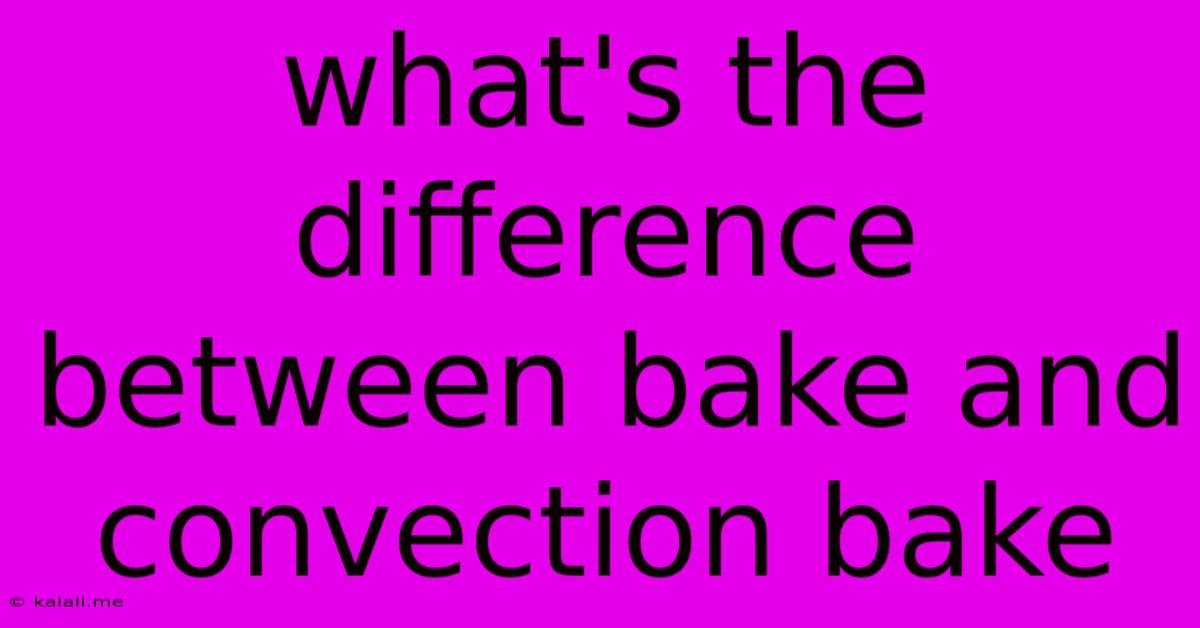What's The Difference Between Bake And Convection Bake
Kalali
Jun 01, 2025 · 3 min read

Table of Contents
Bake vs. Convection Bake: Understanding the Difference for Perfect Baking Results
Choosing between bake and convection bake can significantly impact your baking results. While both methods use heat to cook your food, the way that heat is distributed differs drastically, leading to variations in texture, browning, and cooking time. This article will delve into the core differences between these two cooking modes, helping you achieve baking perfection every time.
What is Bake?
The traditional "bake" setting in your oven uses radiant heat from the bottom and top heating elements. Air within the oven circulates naturally due to the temperature difference, but this movement is relatively slow and uneven. This means that some areas of your oven might be hotter than others, leading to uneven browning and potentially undercooked or overcooked parts of your baked goods. This is particularly noticeable in larger ovens or when baking multiple items simultaneously.
What is Convection Bake?
Convection baking employs a fan to circulate hot air within the oven. This forced air circulation ensures a more even distribution of heat, resulting in faster cooking times and more uniform browning. The fan speeds up the transfer of heat energy, allowing for quicker cooking and reducing the chances of hot spots within the oven cavity. Convection baking is particularly beneficial when cooking multiple items or baking denser items like casseroles and breads.
Key Differences Between Bake and Convection Bake:
Here's a table summarizing the main differences:
| Feature | Bake | Convection Bake |
|---|---|---|
| Heat Source | Radiant heat from top and bottom elements | Radiant heat + fan-circulated hot air |
| Heat Distribution | Uneven, potential hot spots | Even, consistent temperature throughout |
| Cooking Time | Longer | Shorter |
| Browning | Can be uneven | More even, often crispier |
| Best For | Cakes, cookies (smaller batches), some breads | Multiple items, casseroles, breads, roasting |
When to Use Which Setting:
-
Bake: Use the standard bake setting for delicate cakes, cookies (especially when baking only one or two sheets at a time), and recipes specifically designed for conventional ovens. It's also often preferred for items that require a slow and gentle cooking process to develop their flavor and texture.
-
Convection Bake: Opt for convection bake when cooking multiple items simultaneously, roasting meats and vegetables, baking large or dense items like casseroles and breads, or when even browning and faster cooking times are crucial.
Adapting Recipes for Convection Baking:
When using a convection oven, you often need to adjust baking times and temperatures specified in traditional recipes. As convection baking cooks faster, you typically need to lower the temperature by 25°F (14°C) and reduce the cooking time by approximately 25%. However, it's always recommended to monitor your food closely and adjust as needed, as oven variations can still occur.
Conclusion:
Understanding the differences between bake and convection bake empowers you to achieve consistently superior baking results. By choosing the appropriate setting for your recipe and adjusting cooking times and temperatures accordingly, you can unlock the full potential of your oven and create delicious, perfectly baked treats. Remember to always refer to your oven’s manual for specific instructions and recommendations.
Latest Posts
Latest Posts
-
What Is The Everlasting Covenant In Isaiah 24
Jun 03, 2025
-
Where Can I Break A 100
Jun 03, 2025
-
Is Natsu The Main Character In Fairytale
Jun 03, 2025
-
Best Router Bit For Cutting Plywood
Jun 03, 2025
-
How To Prevent Water From Boiling Over
Jun 03, 2025
Related Post
Thank you for visiting our website which covers about What's The Difference Between Bake And Convection Bake . We hope the information provided has been useful to you. Feel free to contact us if you have any questions or need further assistance. See you next time and don't miss to bookmark.